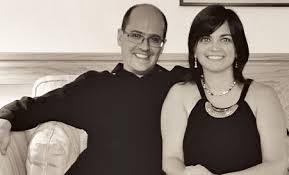Salon Piano Series and the Pro Arte Quartet made Sunday a day to remember
With all due respect to Ernie Banks’ original quote, expressing his joy in the game of baseball, and to the Green Bay Packers and their legions of fans, there was no place I would have rather been last Sunday at 4 p.m. than in the showroom of Farley’s House of Pianos. For this season’s opening concert of the Salon Piano Series, Roberto Plano returned; about a year ago he had been here in a veritable once-in-a-lifetime event with three other dazzling colleagues for “Four on the Floor.” But this year he returned with his wife, pianist Paola Del Negro (pictured above, courtesy of SPS).
The first half of the concert was music for one piano, four-hands, beginning with Schumann’s intriguing suite Bilder aus Osten (“Pictures from the East”). Plano said afterwards that he and Del Negro particularly enjoy this work, since Schumann undoubtedly played it with his wife, the brilliant virtuoso Clara Wieck. Whether or not there was an added element of domestic congeniality in their reading, surely the dominant impression was of warmth and precision—an especially elusive commodity at times in music of such romantic sensibility. Yours truly was grateful once again for hearing music previously unencountered—and we are particularly happy to repeat Plano’s report that he and Del Negro have recorded all the music of Schumann for two pianists, and the CD should be available early in 2018 on the Brilliant Classics label.
Next up wasn’t just music rarely heard—but from a composer who never existed! Ok, it was music published under a pen name, but exceedingly rare nonetheless: “Les amoreaux de Columbine” by “J. Burgmein.” The actual composer was the iconic publisher, G. Ricordi, most famous for urging Verdi to write his final masterpieces, as well as encouraging Puccini early in his career, all while establishing the most important publishing house in Italy. Predictably the six short works fell short of “undiscovered masterpieces” but had their moments of charm and were worth a hearing, especially when given the tender affection and good humor lavished upon them by Plano and Del Negro.
The closing numbers of the first half finally gave the duo rife opportunities to exploit the sonic splendors of the 1950 Steinway instrument on which they were performing. Nos. 2and 5 in the original versions of Brahms’ “Hungarian Dances” flamed to life, and then we were treated to Smetana’s own transcription of his masterful tone poem, “The Moldau.”
Ah, but the second half was the real draw for many in the full house: the two-piano version of what later became Brahms’ Piano Quintet, Op. 34. This is arguably the first towering masterpiece of that lion’s career, emerging first as a string quintet, then the two-piano version and finally the more familiar and famous version. I suppose in retrospect the results were predictable in general: one misses both the mystery and warmth of the strings in the central sequence of the opening movement, as well as in the slow movement and the slow introduction to the finale. But the payoff comes in the sweeping moments of the outer movements as well as the riveting scherzo, and Plano and Del Negro (making her contribution on a 1914 Mason and Hamelin keyboard) gave us all the rafter-shaking thrills we could ask for.
The first encore was a brisk and breezy romp through the “Libertango” of Piazzolla, but the second one was a real surprise: a special arrangement of Lavignaques’ “Galop.” Last year the final encore at last year’s “Four on the Floor” featured all four pianists at one instrument. This time Plano and Del Negro were flanked by their two oldest daughters, standing on either side. Admittedly the arrangement was modified, although mom and dad had their hands full, while Elisa, 11 years old, and Anna, 8 tossed each page in the air with gusto, and played the extreme upper and lower parts with aplomb.
I covered the Pro Arte Quartet extensively beginning in 2011-2012, which was the one hundredth year of continuous performance by any string quartet in history. The celebrations spilled over to the beginning of 2013 with the first performance of the last of six world premieres the group had commissioned. But since then I’ve failed to get them on my live listening schedule, and there were two compeling reasons to make Sunday a doubleheader and head over from the delightful post-Salon Piano Series reception to Mills Hall to catch the quartet.
Or rather to hear three members of the PAQ and two guests. Cellist Parry Karp, the longest-tenured player in the 105 year history of the ensemble, continues to recover from a condition that has silenced his cherished artistry for several months. The latest word is that Karp hopes to resume playing in November, and WGS continues to hope and pray that this is so. One hates to imagine what it feels like to be forced to abandon a lifelong pursuit, even for a matter of months, and we all look forward to the day Karp resumes his 41-year position anchoring this gem of a group.
In the short term one needn’t have worried about the group’s performance; indeed, aside from the unfortunate circumstances that caused it, one looked forward to hearing the group with the guest cellist Jean-Michel Fontenau. He has been heard here many times with the Bach Dancing and Dynamite Society, both in various groups and as a member of his long-time ensemble, the San Francisco Piano Trio.
The program was simply two masterworks of Mozart, beginning with the String Quartet in G Major, K. 387. Did you ever hear silk? Well, now I can say I have. The overall balance was perfect throughout, and Fontenau communicated with first violinist David Perry as though they were clones (and this is meant as the highest praise!). Second violinist Suzanne Beia and violist Sally Chisholm were every bit the perfect pair, whether in their roles as inner voices or when Mozart gave them a brief spotlight.
The only way to top that reading was to turn to not only one of Mozart’s late masterpieces, but arguably one of the finest chamber works ever penned, the Quintet for Clarinet and Strings, K. 581. You don’t have to be a clarinetist a la yours truly to want to hear the work many times, but the particular attraction Sunday was the local debut on new UW Mead School of Music member, Alicia Lee.
Her performance pedigree, which includes time spent with the Orpheus Chamber Orchestra and Alarm Will Sound, would indicate that Lee would be entirely at home in any chamber ensemble setting, and her playing Sunday night bore that out. Add in a velvety tone, lovingly nuanced in all registers, and equal sensitivity to Mozart and her colleagues, and we had a winning combination to savor. Happily, Mills Hall was nearly full on the lower level, and the audience was quick to express its strong approval. All we need now is to celebrate Parry Karp’s return…

